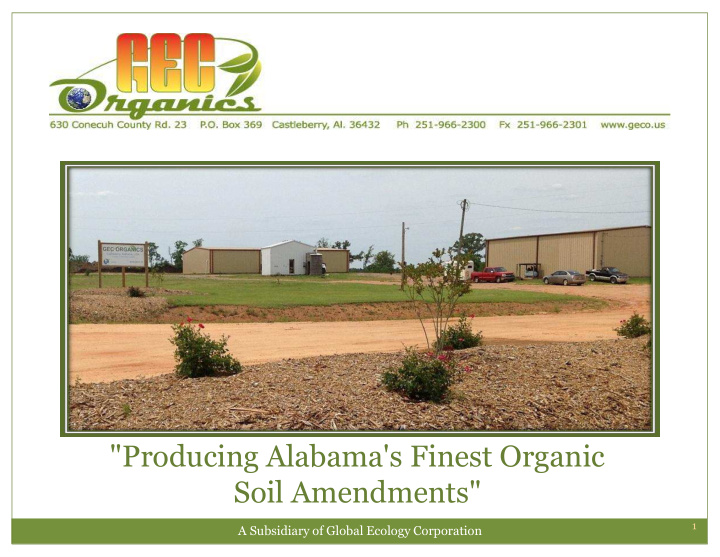



"Producing Alabama's Finest Organic Soil Amendments" 1 A Subsidiary of Global Ecology Corporation
USDA Concerns "The National Academy of Sciences reports that at least one out of seven people are significantly harmed by agricultural pesticide exposure each year" "There is increased concern among farmers, environmental groups, and the general public about adverse effects of the U.S. agricultural production system, particularly the extensive and often excessive use of agricultural chemicals, both fertilizers and pesticides" - USDA "Due to environmental concerns, USDA officials are hoping farmers will switch to more sustainable organic agricultural production practices" 2
Farmers & USDA Concerns Continued decline in soil productivity from excessive soil erosion and nutrient runoff losses. Contamination of surface and groundwater from fertilizers and pesticides. Increased cost of, and dependence on, external inputs of chemical fertilizers. Hazards to human and animal health and to food quality and safety from agricultural chemicals. 3
Problems With Synthetic Fertilizers Synthetic Fertilizer use results in: Loss of topsoil through erosion Loss of water absorption Chemical leaching Water pollution Disease and insect prone crops Decrease in crops nutritional value (protein, vitamins, & minerals) Increased cost of, and dependence on, external inputs of chemical fertilizers Fuel prices, & H20 4
GEC Organics – Castleberry, Alabama Located in Castleberry Alabama, our 70 acre composting site can produce up to 20,000 yards of the most nutrient rich organic fertilizer and over 30,000 gallons of organic compost teas and soil inoculants each month. Our goal is to help farmers dramatically improve the quality and health of their soil and crops, while reducing their dependency on synthetic fertilizers! 5
OSA1000 TM Compost Most all compost soil amendments are created by mixing green waste products with various types of animal manure. At GEC Organics, in an effort to achieve continuous flow of compost with consistent nutrient values, we use only nutrient-rich chicken litter combined with high carbon-value wood shavings and other quality green waste materials. The proportions of each material are measured by weight before adding them to the windrow. We then add our Proprietary microbe activation formula to instantly neutralize the foul odor and in 3 to 4 weeks the result is a ready to use, odorless , sweet smelling compost. 6
The composting process begins with the delivery of organic waste materials from nearby chicken broiler farms and wood shavings and potash materials from nearby lumber operations. We weigh each load as it’s delivered to our site.
The company constructed a heavy duty cement plat form to receive the tons of chicken litter. This was done to prevent excessive nutrient leaching into the local soil and preserve the proper consistency of the material. The other non-toxic organic materials are also weighed and staged in separate piles prior to being combined in windrows with the chicken litter.
The three material ingredients of the compost are added proportionally to form a composting windrow. Chicken litter, because of its high nutrient value and microbe and diverse microbe populations, is the main ingredient. Wood shavings for their carbon value, which balances the chicken litter and sawdust for moisture control. Granulated charcoal from lumber waste is added to increase potash levels in the compost. Once the composting materials have been distributed to the windrows, we begin the windrow mixing process. It is during this phase that we add our proprietary OSA101liquid to accelerate the population growth of the dominant aerobic microbes. These microbes attack the odor-causing anaerobic microbes, eliminating them within a 24 hour period.
After the windrows are assembled, they are turned every 3 or 4 days for approximately two weeks. Windrow temperatures are taken and record several times a day to make sure that the 160 degrees limit is not exceeded. When we are confident that the windrows have been entirely exposed to the optimum temperatures, they are consolidated into a larger pile and left to cure and cool down to the ambient temperature.
When the curing process is complete and the moisture levels are right, the compost is moved to a covered area for screening. The screened compost will remain in a covered area to be bagged and shipped to retail outlets or shipped in bulk to local farmers.
Here we are delivering our first bulk sale of compost to a hay farmer. Again, every load of raw materials entering the property or finished compost leaving, is weighed on our scales.
The company also produces a highly nutritious Compost Tea and a Microbial Soil Inoculant at the Castleberry Site. These freshly made products are complements to our compost and we anticipate building a large market for them over the next year.
Expected Results Our proprietary compost, liquid soil amendments and composting process will greatly improve overall soil quality provide the following benefits: Increased soil water retention up to 50% Odorless Drought resistant Reduce the need for or even eliminate the need for synthetic fertilizers Reduce the need for or even eliminate the need for pesticides Accelerated seed germination times Larger and stronger plant root systems resulting in healthier plants, trees and turf Greater crop yields Faster blooming times Increased nutrient storage aiding fertilizer runoff control 14
This is an example of the size of a single market for our products in Alabama: Around 230,000 acres of corn has been planted each year for grain production in Alabama over the last decade. Corn is grown as a part of crop rotation systems that include cotton and peanuts. Other Major Alabama Crops Include (2010/2011): Corn Grain 270,000 Sweet Corn 1,800,000 Hay 780,000 Soybeans 190,000 Winter Wheat 150,000 Blueberrys 340,000 Total Acres Planted 3,530,000
Recommend
More recommend